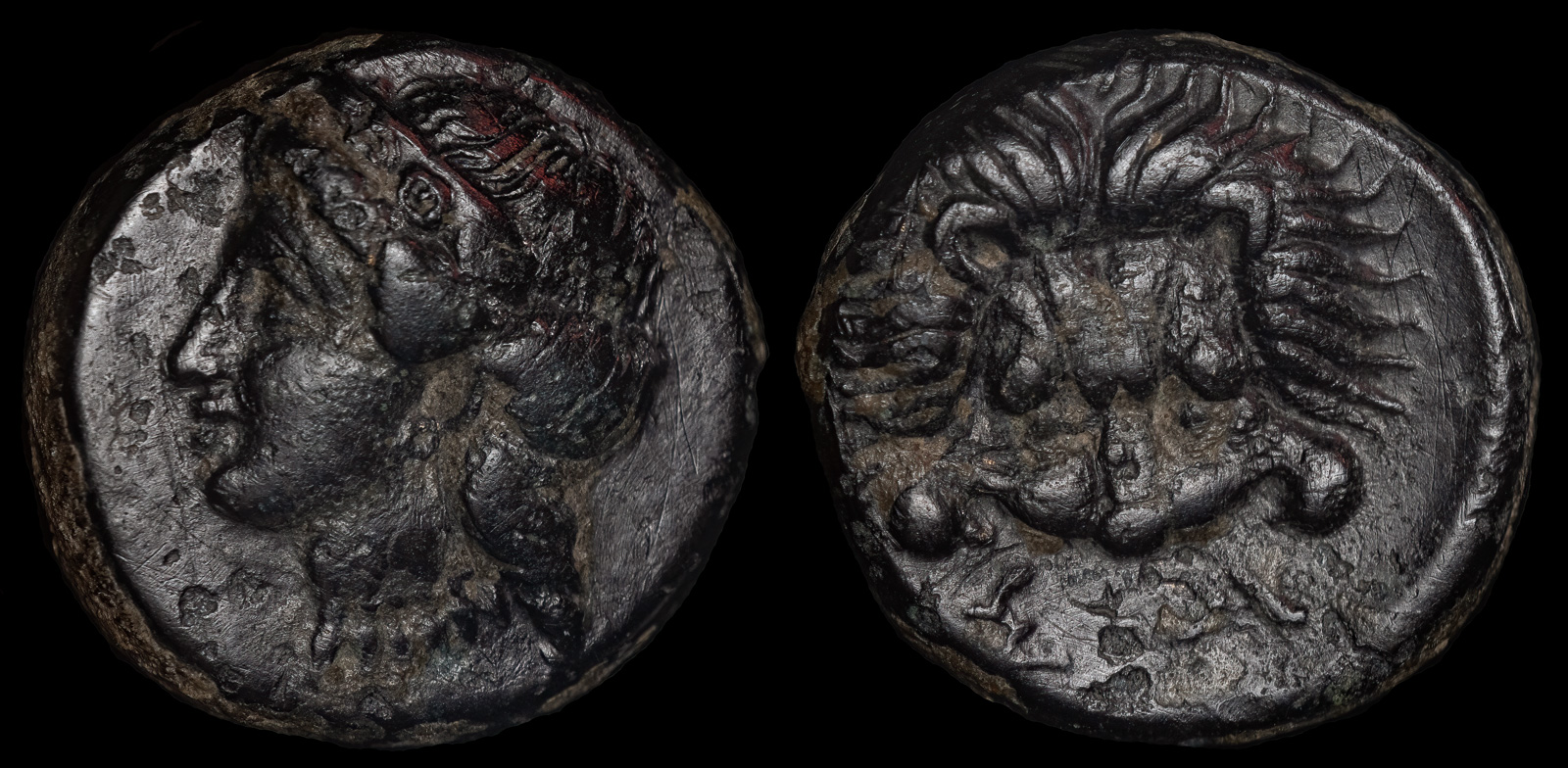
Islands off Ionia. Samos
circa 408-380 BCE
Æ 12 mm, 1,73 g
Head of Hera left, wearing stephane, necklace, and earring
Facing lion’s head; Σ-Α below.
very fine
BMC Ionia pg. 364, 147; SNG von Aulock 2296.
Samos is the home of the Tunnel of Eupalinos, which is over one kilometer long and which served as an aqueduct. It was a marvel of engineering for the time because it was excavated from both sides using geometry to calculate the digging. So amazing was the tunnel at the time that Herodotus covered it in length.
We don’t know exactly when the tunnel was constructed, but it may have been in the 6th century BCE. It served its purpose for 1100 years before silting up, and is today a tourist attraction.
The island contained multiple cities. There was the ancient town of Samos itself and Pythagoreion, where the tunnel leads. The island also had one of the most famous temples to Hera in antiquity, the Heraion. Ruins of the temple may still be seen. Herodotus during his time stated it was the largest temple he knew of. It is believed to have honored Hera’s birth.
Samos was a very powerful island in antiquity and founded numerous colonies, including Bisanthe, Perinthos, Samothrace, Kydonia, Nagidos, and Kelenderis. Their principal rival in the region was Miletos, with whom they eventually fought a war.
Numerous famous people from antiquity were from Samos, but perhaps the two most known to us are the mathematician Pythagoras and Aesop, of fable fame.
During the diadochi period, Samos for some time was the main naval base of the Ptolemies.

Islands off Ionia, Samos
Circa 310 BCE
Dichalkon Bronze, 16 mm, 4.14 g, 1 h
struck under the magistrate Ariston
Diademed head of Hera to right
Rev. ΑΡΙΣΤΩN Facing lion scalp
HGC 6, 1247. SNG Copenhagen 1703
Perinthos founded by settlers from Samos.
The Temple of Hera at Samos is completed.
Approximate foundation of Nagidos by settlers from Samos.
The Temple of Hera and much of the ancient city of Samos are destroyed.
Approximate time when Polykrates becomes tyrant of Samos. He is supported by Lygdamis of Naxos.
Polykrates pays off Spartans besieging Samos with counterfeit coins.
Arkesilaos III returns to Kyrene from Samos and is able to take the city. Fearing a backlash, he leaves to his father-in-law in Barka, where he is recognized by exiles and killed. His mother Pheretima takes over Kyrene.
The Battle of Lade is fought between the Ionians under Dionysos of Phokaia and the Persians. Chios has the largest contingent, followed by Miletos, Lesbos (probably Mytilene), Samos, Teos, Priene, Erythrai, Myos, and Phokaia. Most fled during the battle, but the Chians put up a bold resistance before defeat.
August 27
Samos revolts from Athens. Sparta considers war in their support, but the matter is put to a vote and Corinth disagrees. Peace between Sparta and Athens continues and Athens squashes the revolt.
Sparta defeats the Athenian fleet based in Samos.
Samos serves as a temporary home for the Athenian democracy.
Samos declares its independence and re-establishes a democracy.
Peace of Antalkidas, arranged by Artaxerxes II, is signed in Susa, ending the Corinthian War. Abydos, Aigai, Kalchedon, Kaunos, Klazomenai, Kyzikos, Parion, Samos, and Adramytteion become part of the Persian Empire.
Eresos, Byzantion, Chios,Mytilene, Methymna, Rhodes, Thebes, Korkyra, Eretria, Kios, Samos, Naxos, Andros, Myrina (Lembos), Hephaistia, Imbros, and Thasos join the Second Athenian League, reaffirming its alliance with Athens in response to the growing threat of Persian interference and internal Greek conflicts.
Samos is taken by Athens after a siege of eleven months.
355 BCE
The Second Syrian War ends. Ptolemy II cedes land to Antiiochos II and Antigonos II remains in mastery of Greece. Antiochos II takes control over Ephesos, Samos, and Miletos.
Samos is given by the Romans to the Attalids.
Samos sides with the pretender Eumenes III against Rome.
Adramytteion, Ephesos, Pergamon, Magnesia, Tralles, Apamea, Samos, Kolophon, Smyrna, and Sardis occupied by Mithridates VI as part of the Mithridatic Wars against Rome.